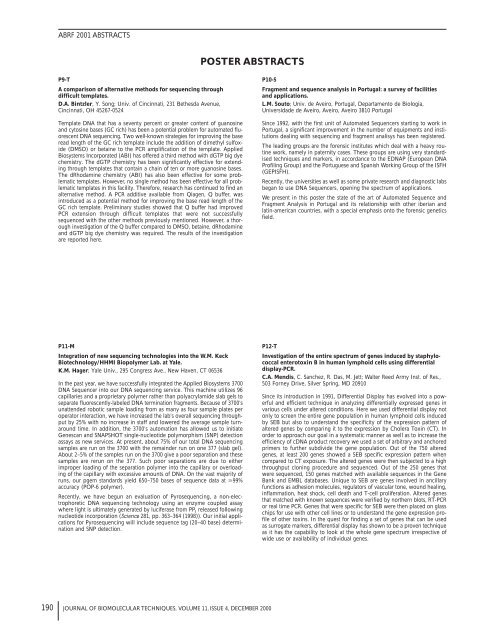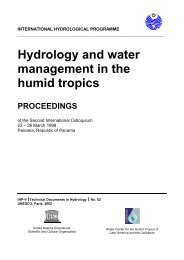FR AB - Science Reference
FR AB - Science Reference
FR AB - Science Reference
You also want an ePaper? Increase the reach of your titles
YUMPU automatically turns print PDFs into web optimized ePapers that Google loves.
<strong>AB</strong>RF 2001 <strong>AB</strong>STRACTS<br />
P9-T<br />
A comparison of alternative methods for sequencing through<br />
difficult templates.<br />
D.A. Bintzler, Y. Song; Univ. of Cincinnati, 231 Bethesda Avenue,<br />
Cincinnati, OH 45267-0524<br />
Template DNA that has a seventy percent or greater content of guanosine<br />
and cytosine bases (GC rich) has been a potential problem for automated fluorescent<br />
DNA sequencing. Two well-known strategies for improving the base<br />
read length of the GC rich template include the addition of dimethyl sulfoxide<br />
(DMSO) or betaine to the PCR amplification of the template. Applied<br />
Biosystems Incorporated (<strong>AB</strong>I) has offered a third method with dGTP big dye<br />
chemistry. The dGTP chemistry has been significantly effective for extending<br />
through templates that contain a chain of ten or more guanosine bases.<br />
The dRhodamine chemistry (<strong>AB</strong>I) has also been effective for some problematic<br />
templates. However, no single method has been effective for all problematic<br />
templates in this facility. Therefore, research has continued to find an<br />
alternative method. A PCR additive available from Qiagen, Q buffer, was<br />
introduced as a potential method for improving the base read length of the<br />
GC rich template. Preliminary studies showed that Q buffer had improved<br />
PCR extension through difficult templates that were not successfully<br />
sequenced with the other methods previously mentioned. However, a thorough<br />
investigation of the Q buffer compared to DMSO, betaine, dRhodamine<br />
and dGTP big dye chemistry was required. The results of the investigation<br />
are reported here.<br />
P11-M<br />
Integration of new sequencing technologies into the W.M. Keck<br />
Biotechnology/HHMI Biopolymer Lab. at Yale.<br />
K.M. Hager; Yale Univ., 295 Congress Ave., New Haven, CT 06536<br />
In the past year, we have successfully integrated the Applied Biosystems 3700<br />
DNA Sequencer into our DNA sequencing service. This machine utilizes 96<br />
capillaries and a proprietary polymer rather than polyacrylamide slab gels to<br />
separate fluorescently-labeled DNA termination fragments. Because of 3700’s<br />
unattended robotic sample loading from as many as four sample plates per<br />
operator interaction, we have increased the lab’s overall sequencing throughput<br />
by 25% with no increase in staff and lowered the average sample turnaround<br />
time. In addition, the 3700’s automation has allowed us to initiate<br />
Genescan and SNAPSHOT single-nucleotide polymorphism (SNP) detection<br />
assays as new services. At present, about 75% of our total DNA sequencing<br />
samples are run on the 3700 with the remainder run on one 377 (slab gel).<br />
About 2–5% of the samples run on the 3700 give a poor separation and these<br />
samples are rerun on the 377. Such poor separations are due to either<br />
improper loading of the separation polymer into the capillary or overloading<br />
of the capillary with excessive amounts of DNA. On the vast majority of<br />
runs, our pgem standards yield 650–750 bases of sequence data at �99%<br />
accuracy (POP-6 polymer).<br />
Recently, we have begun an evaluation of Pyrosequencing, a non-electrophoretic<br />
DNA sequencing technology using an enzyme coupled assay<br />
where light is ultimately generated by luciferase from PPI released following<br />
nucleotide incorporation (<strong>Science</strong> 281, pp. 363–364 (1998)). Our initial applications<br />
for Pyrosequencing will include sequence tag (20–40 base) determination<br />
and SNP detection.<br />
POSTER <strong>AB</strong>STRACTS<br />
190 JOURNAL OF BIOMOLECULAR TECHNIQUES, VOLUME 11, ISSUE 4, DECEMBER 2000<br />
P10-S<br />
Fragment and sequence analysis in Portugal: a survey of facilities<br />
and applications.<br />
L.M. Souto; Univ. de Aveiro, Portugal, Departamento de Biologia,<br />
Universidade de Aveiro, Aveiro, Aveiro 3810 Portugal<br />
Since 1992, with the first unit of Automated Sequencers starting to work in<br />
Portugal, a significant improvement in the number of equipments and institutions<br />
dealing with sequencing and fragment analisys has been registered.<br />
The leading groups are the forensic institutes which deal with a heavy routine<br />
work, namely in paternity cases. These groups are using very standardised<br />
techniques and markers, in accordance to the EDNAP (European DNA<br />
Profiling Group) and the Portuguese and Spanish Working Group of the ISFH<br />
(GEPISFH).<br />
Recently, the universities as well as some private research and diagnostic labs<br />
began to use DNA Sequencers, opening the spectrum of applications.<br />
We present in this poster the state of the art of Automated Sequence and<br />
Fragment Analysis in Portugal and its relationship with other iberian and<br />
latin-american countries, with a special emphasis onto the forensic genetics<br />
field.<br />
P12-T<br />
Investigation of the entire spectrum of genes induced by staphylococcal<br />
enterotoxin B in human lymphoid cells using differential<br />
display-PCR.<br />
C.A. Mendis, C. Sanchez, R. Das, M. Jett; Walter Reed Army Inst. of Res.,<br />
503 Forney Drive, Silver Spring, MD 20910<br />
Since its introduction in 1991, Differential Display has evolved into a powerful<br />
and efficient technique in analyzing differentially expressed genes in<br />
various cells under altered conditions. Here we used differential display not<br />
only to screen the entire gene population in human lymphoid cells induced<br />
by SEB but also to understand the specificity of the expression pattern of<br />
altered genes by comparing it to the expression by Cholera Toxin (CT). In<br />
order to approach our goal in a systematic manner as well as to increase the<br />
efficiency of cDNA product recovery we used a set of arbitrary and anchored<br />
primers to further subdivide the gene population. Out of the 750 altered<br />
genes, at least 200 genes showed a SEB specific expression pattern when<br />
compared to CT exposure. The altered genes were then subjected to a high<br />
throughput cloning procedure and sequenced. Out of the 250 genes that<br />
were sequenced, 150 genes matched with available sequences in the Gene<br />
Bank and EMBL databases. Unique to SEB are genes involved in ancillary<br />
functions as adhesion molecules, regulators of vascular tone, wound healing,<br />
inflammation, heat shock, cell death and T-cell proliferation. Altered genes<br />
that matched with known sequences were verified by northern blots, RT-PCR<br />
or real time PCR. Genes that were specific for SEB were then placed on glass<br />
chips for use with other cell lines or to understand the gene expression profile<br />
of other toxins. In the quest for finding a set of genes that can be used<br />
as surrogate markers, differential display has shown to be a proven technique<br />
as it has the capability to look at the whole gene spectrum irrespective of<br />
wide use or availability of individual genes.















